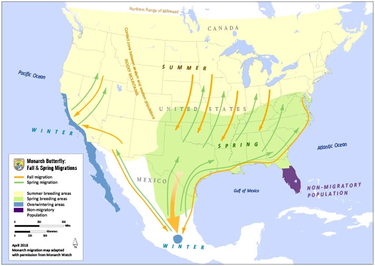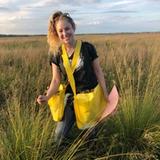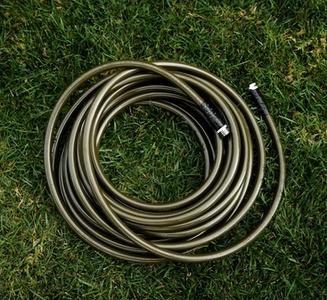Why do monarchs migrate?
Monarchs are unable to survive cold temperatures in northern climates, so in the fall, they migrate south to overwintering locations to roost (or rest!).
Yet their migration travels and roosting sites vary greatly. Monarchs in Mexico roost in oyamel fir trees, while monarchs in California roost in eucalyptus, Monterey pines, and Monterey cypresses. Regardless of location, the butterflies will roost in massive clusters, sometimes with thousands of butterflies on a single tree.
Fun Fact: Not all monarchs migrate! There are populations of monarch butterflies in Florida that can survive throughout the year without migrating to warmer climates.
What does monarch migration look like

When do monarchs migrate?
Like birds, monarchs complete a two-way migration (north and south). The fall migration season for monarchs occurs from September through early November and begins when temperatures cool in their summer regions. Monarchs are only on the move during daylight hours.
How do monarchs migrate?
How monarchs navigate is still not entirely known, but it might be related to magnetic pull or the direction of the sun.
What we do know is that monarchs use a combination of air currents and air thermals (columns of warm rising air) to travel up to 3,000 miles to their overwintering grounds.
Where do monarchs migrate?
Migration pathways across the US and Canada lead into warm coastal areas of California, Baja California, central Mexico, and southern Mexico. Monarchs east of the Mississippi head to Mexico, while western monarchs overwinter in California.
How to build a stop-over habitat for monarchs
Monarch migration is one of the longest-standing migrations in North America. Additionally, monarchs help pollinate ecosystems, raise awareness of critical habitat conservation needs, and promote pollinator protection actions we can all adopt in our sustainability journey.
Plant milkweed
If you're in an area where milkweed can be planted, plant it! Milkweed (Asclepias spp.) is the host plant for monarchs, and we can’t emphasize enough that monarchs need this plant to survive. They lay their eggs on the leaves for growing caterpillars to consume until they transform into their chrysalis. In short, it’s essential to every phase of the monarch's lifecycle.
Find the best milkweed species for your yard here.
Sunday Tip: There are milkweed lookalikes that are poisonous to monarchs and other wildlife, so beware of swallow-worts!
Grow a pocket prairie
Nectar sources are the second most important resource and habitat component for monarchs. While milkweed is vital for monarch caterpillars, adult butterflies can’t survive off of milkweed nectar alone, so make sure to plant various butterfly-friendly flowering native plants to provide food to adult monarch butterflies.
Provide water and heat sources
Cold-blooded monarchs need places to warm themselves and stop for a drink during their migratory journeys. Strategically placed rocks and areas where water can collect will help our winged friends thrive.
Think before managing your yard
Monarchs already have enough obstacles when migrating to and from overwintering locations. When you care for monarchs, you’re also doing better for your family, pets, and the planet as a whole.
- Avoid planting invasive species that overtake native habitats.
- Don't use pesticides, or only opt for them as a last resort. When you do need to, use them responsibly, sparingly, and according to the label instructions.
- Never spray flowering plants with pesticides that will harm pollinators.
Help monarchs find their way
Support monarch conservation through learning, volunteering, advocacy, and more. Anyone can be a pollinator advocate—and it can be as easy as keeping up to date with the latest pollinator news, or as involved as becoming a community scientist!
- Follow Sunday’s 1% for the Planet pollinator partners: Pollinator Partnership, People & Pollinator Action Network, and Audubon Rockies
- Join Monarch Watch — a cooperative network of students, teachers, and researchers dedicated to the study of the Monarch
- Register your native garden with the Monarch Waystation to support monarch conservation.
- Get involved with the Monarch Joint Venture program to take part in community science efforts and learn how you can support pollinators in your community.
CITED SOURCES
Fall-Migrating Monarchs. Penn State Extension.
Monarch Butterflies. Cornell Cooperative Extension.
Monarch Butterflies Bring Together Conservation and Culture. The Nature Conservancy.
Monarch butterflies facing a crisis. University of Illinois Extension.
Monarch Butterfly. Texas A&M Extension.
Monarch Butterfly. U.S. Forest Service.
Monarch Butterfly Conservation in North America. U.S. Forest Service.
Monarch Butterfly Fact Sheet. University of Maine Extension.
Viceroy butterfly - Limenitis archippus (Cramer). University of Florida Extension.



















